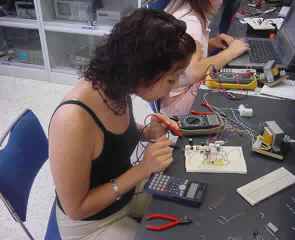How to install a power outlet and switch
 It would seem that in such an area as the wiring of sockets and switches, there can be nothing new. However, this is not so. The technology of their installation and the design itself are being improved. For flush mounting, they are installed in universal mounting boxes, made mainly of plastic. On the back of the box are easily removable plugs designed to enter wires of various diameters and tubes protecting them.
It would seem that in such an area as the wiring of sockets and switches, there can be nothing new. However, this is not so. The technology of their installation and the design itself are being improved. For flush mounting, they are installed in universal mounting boxes, made mainly of plastic. On the back of the box are easily removable plugs designed to enter wires of various diameters and tubes protecting them.
Boxes designed for installation in hollow walls are equipped with special fixing screws with tabs that can fix the product on the front surface of the wall made of any material from 1 to 35 mm thick. The holes for the boxes in the hollow walls are drilled using a special nozzle, the diameter of the cutting part of which is equal to the diameter of the box. The standard diameter is 68 mm.
If the mounting boxes are installed in stone and concrete walls, they are connected to them through channels in wall panels or through flexible plastic corrugated pipes laid in strobes. The box itself is usually fixed in the wall opening with gypsum, cement-sand mortar or special glue ...
The device and principle of operation of a simple electric motor
 An electric motor is simply a device for efficiently converting electrical energy into mechanical energy.
An electric motor is simply a device for efficiently converting electrical energy into mechanical energy.
This transformation is based on magnetism. Electric motors use permanent magnets and electromagnets, in addition, they use the magnetic properties of various materials to create these amazing devices.
There are several types of electric motors. We note two main classes: AC and DC.
Class AC motors (Alternating Current) require an AC or voltage source to operate (you can find such a source in any electrical outlet in the house).
Electric motors of DC (Direct Current) class require a direct current or voltage source to operate (you can find such a source in any battery).
Universal engines can work from any type of source.
Not only the design of the engines is different, the methods of controlling speed and torque are different, although the principle of energy conversion is the same for all types ...
Using the block-sequential method for troubleshooting electrical circuits

What is a block? A certain device or part of the circuit selected by us, having the so-called “input” and “output” for signal transmission, and the input “power”.
Consider a simple circuit where, as such, there is no control signal, its function is performed by directly turning on the power to the executing mechanism (output device).
Further, in this case, the concepts of “input” and “output” will be applied to the transmission of the supply voltage.
Any device in itself can be thought of as a separate unit. For example, we inserted the plug into a power outlet, made an “input”, and at the “output” we get the result: we watch TV, the iron is heating, the music sounds, etc.
Take, for example, a lamp - a night lamp with rotating light filters and a 12-volt incandescent lamp. We divide the object, for convenience, into separate blocks ...
